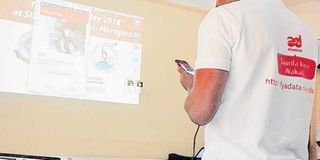Tanzanians on digital mission in Ebola-hit Congo

Mr Erick Beda, an IT specialist from Sokoine University of Agriculture (SUA) demonstrates how AfyaData works. Photo by Syriacus Buguzi.
What you need to know:
- The digital app, AfyaData, was developed by researchers at SUA in collaboration with ICT experts to improve efficiency in surveillance of diseases.
- Here’s why Congo was interested in it during Ebola outbreak.
Dar es Salaam. In mid-June this year, over a month after Ebola resurfaced in the Democratic Republic of Congo, a fortnight-long mission began for Mr Eric Beda, a Tanzanian IT scientist and his colleagues, Renfrid Ngolongolo and Calvin Sindato, an epidemiologist.
“We were going to train staff [in Congo] so that they could train others on how to use our digital tools, ‘AfyaData’, for Ebola control and research,’’ says Mr Beda from Sokoine University of Agriculture (SUA).
SUA’s research activities on epidemics are being coordinated by the Southern African Centre for Infectious Disease Surveillance (SACIDS) based in Morogoro Region.
The university sought to apply the digital application that its experts had developed, by deploying a team in Ebola-hit areas to support early detection, timely reporting and prompt response to the outbreak.
While in the DRC, the SACIDS team, comprised of Beda and his colleagues, liaised with the National Institute of Biomedical Research (NIBR) to setup an AfyaData resource hub, the training of trainers and the digitisation of various surveillance forms to be used in Ebola monitoring and evaluation.
Since May 8, this year, the DRC’s Ministry of Health of Health declared an outbreak of Ebola Virus Disease (EVD) in Bikoro Health Zone, Equateur Province. This is the 10th outbreak of the viral disease since it was first reported in the country in 1976.
How secondary school’s French helped
At the back of his mind, Beda knew DRC was an entirely different country—culturally, but the contacts he had made with people on the ground when he last visited the country, coupled with his Form II French, meant that he was already highly motivated to navigate through to get his message across.
“…I personally was challenged by language barrier but a combination of form II French and local contacts [I had made] made us fare well,’’ he recalls, as he speaks to Your Health after his return from the capital Kinshasa, DRC—a country now battling two enemies: Ebola and political conflict.
The World Health Organisation (WHO) says that by October this year, 106 people had died of Ebola in DRC and several others hospitalised.
“So far there are a total of 161 confirmed and probable cases. There are 45 survivors and several people still under care,’’ says the WHO’s Director General Dr Tedros Ghebreyesus in his recent report.
Focus was on control and research
Beda and Sindato, believe that AfyaData, a smartphone application that works by empowering communities to detect and report epidemics including Ebola, can help medical teams in DRC to track cases of the disease before it spreads.
But, in the latest mission, the focus was on Ebola control and research—not detection. “... we liaised with some groups [on the ground]…participated in the weekly Ebola outbreak update meetings at Congo’s Ministry of Health,” says Beda.
Although the application of technology in fighting Ebola wasn’t something new in DRC, Beda and his colleague, all from SUA, sought to spread the technology in areas where it was lacking.
What’s AfyaData?
The digital app, dubbed AfyaData, which is available for download on Google Play store, was developed by researchers at SUA in collaboration with ICT experts, including Beda, from the Southern African Centre for Infectious Disease Surveillance (SACIDS).
The app, funded by a US-based organisation, Ending Pandemics, works by enabling people—trained as community health reporters who collect details on signs and symptoms of suspected diseases in communities, enter the information via the app and send it to a server where it is stored, synthesised and analysed by experts.
The experts who receive the details can then make a diagnosis and provide feedback or inform the relevant authorities to contain a potential outbreak in real time. This, according to Beda, was useful in areas with an outbreak such as DRC.
The app can be used to provide details about a location of a problem via GPS. It can also provide the data on the extent of the problem, depending on the amount of details that people in communities can feed into the app.
The idea to develop the app started in 2014, during a collaborative event which was held in 2014 in Tanzania involving 66 health experts from North and South America, Africa and Asia.
The experts met to identify the challenges facing early detection and timely reporting of viral outbreaks. A year later, a project to develop the app was launched.
Professor Esron Karimuribo from SUA, whose research facilitated the development of the app, says that the digital tool would help in surveillance activities locally and beyond.
“AfyaData, complements the strategies put in place to improve efficiency in surveillance of infectious diseases in Tanzania, regionally and globally,’’ he says.
The tech tool was launched in May 24 this year and since then, the DRC has sought to engage SACIDS experts on how the app could be used to track Ebola cases in the ongoing outbreak.
What Beda found in DRC
“There has been some use of technology [in dealing with the outbreak in DRC] but it not part of the operations by the unit [which we were working with],’’ says Beda, narrating to Your Health about lessons his team has picked from the DRC mission.
“There was an issue of data sensitivity…we realised, through our discussions with epidemiology team at Ministry of Health in Kinshasha, that hosting of data in Tanzania [where our current servers is now located] was not ethically sound...we have been looking into setting up a server system in DRC,’’ he reveals.
“From interviews with personnel who went to affected areas.... the main challenge is [poor] mobile network coverage. Mobile network is close to non-existent in those areas,’’ he explains.
So far, SACIDS says, “The feedback on AfyaData [in DRC] was positive; it was considered a useful application for enhancing early reporting of EVD as well as helping to reduce the workload associated with paper-based systems.”
Other countries such as Uganda, Kenya and Thailand have also expressed their intention to import the technology from Tanzania.
Why the technology matters for Africa
Various studies show diseases such as Ebola, originated in Africa, continue to exert a massive toll on the continent, exacerbated by poverty, malnutrition and poor health facilities.
Yet Africa remains a continent that falls far short of the infrastructure and resources needed to detect, monitor, control and prevent disease outbreaks effectively and efficiently. This, of AfyaData, comes as an attempt to improve the services.
Health services in Tanzania and in many countries across Africa are underfunded, poorly equipped and fall far short of the basics needed to serve a rapidly growing population.
For decades, there have been reports of poor transport networks, outdated equipment, substandard facilities, and inadequate drug supplies have left many health services in a woeful state.
Low budgets and political short-termism lead many governments to resist funding health systems and disease research properly until they are forced to – that is, until a crisis occurs.
This weakness has been revealed in times of disaster such as the outbreaks of Ebola in 2014-2016. The outbreak revealed the devastation, especially when governments failed to ensure robust health systems and local mechanisms for detecting and monitoring disease.




